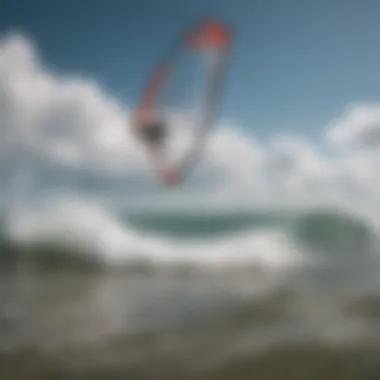Mastering Kitesurfing with Accurate Wind Forecasts


Intro
Kitesurfing is a sport that profoundly depends on wind conditions. Understanding the nuances of wind forecasts is essential for both optimal performance and safety. Many kitesurfers rely on various sources for wind predictions, which can often lead to confusion or misinterpretations. This guide aims to demystify wind forecasting for kitesurfing, addressing factors like methodologies for obtaining accurate data, the significance of wind patterns, and how they influence riding conditions.
Furthermore, kitesurfers face common myths and misconceptions about wind forecasts. This piece will clarify these misunderstandings, helping enthusiasts be better prepared for their sessions on the water. It will also explore the relationship between local geographical features and wind characteristics, offering useful insights into navigating different conditions. With technology continuously evolving, a sneak peek into the future of forecasting methods is equally important.
By unraveling these complex themes, the article serves as a comprehensive resource for anyone wanting to enhance their understanding of wind forecasting in kitesurfing.
Equipment Reviews
Evaluating kitesurfing gear is vital for catering to diverse preferences and styles among k surfers. It's crucial to understand how the design and features of kites, boards, and accessories affect performance and safety.
Kites
In the world of kites, staying current with the latest models can be daunting. Various designs cater to different wind conditions and skill levels. For example, brands like Duotone, Naish, and Cabrinha all offer distinct kite shapes.
- C-shaped kites are excellent for upwind performance and great for jumping.
- Delta-shaped kites offer wider wind ranges and stability, making them suitable for beginners.
Kite sizes also play a significant role. A larger kite catches more wind, which is useful in lighter conditions, while smaller kites excel in higher winds. Understanding materials is equally important. Modern kites usually utilize ripstop nylon, enhancing durability and reducing weight.
Boards
The type of board impacts riding style and maneuverability. Twintip boards are predominantly favored by new riders due to their ease of use. Directional boards, on the other hand, provide superior performance in waves and are geared toward experienced kitesurfers. Brands like Slingshot and F-One are renowned for their innovative designs.
- Twintips: Designed for both regular and goofy stances, they allow versatility.
- Directional boards: Better for specific conditions, offering refined performance.
Accessories
Accessories often get overlooked but play a key role in enhancing safety and comfort on the water. Essential items include:
- Harnesses: Ensure comfort and prevent fatigue.
- Lines and Leashes: Proper lines maintain control and safety.
- Pumps: Fast deflation and inflation are crucial to getting on the water quickly.
Regularly checking the condition of these items, especially safety gear like impact vests and helmets, is paramount.
Proper equipment selection can significantly elevate your kitesurfing experience. Choose wisely.
Understanding Wind Dynamics in Kitesurfing
Understanding wind dynamics is vital for any kitesurfer. Wind is the primary driving force behind the sport. Knowledge of wind formation, types, and effects on performance can significantly influence the experience and safety during kitesurfing.
Wind dynamics involves various aspects: how winds are formed, their characteristics, and how they directly affect kitesurfing. It is essential for selecting suitable locations and times to practice. When kitesurfers comprehend the intricacies of wind, they are better equipped to interpret forecasts and respond to changing conditions. This understanding can also enhance skills and techniques, leading to improved performance on the water.
The Basics of Wind Formation
Wind is formed due to the uneven heating of the Earth's surface by the sun. Different surfaces, such as land and water, absorb and radiate heat differently, leading to variations in air pressure.
Key factors in wind formation include:
- Temperature differences: Warm air rises, creating low-pressure areas, while cooler air sinks, forming high-pressure zones.
- Coriolis effect: This effect, caused by the Earth's rotation, influences wind direction. It causes moving air to curve to the right in the Northern Hemisphere and to the left in the Southern Hemisphere.
- Topography: Mountains, valleys, and other geographical features can shape wind patterns. For instance, winds may increase in speed as they pass through narrow valleys.
Understanding these processes helps kitesurfers anticipate wind behavior and conditions better.
Types of Winds and Their Characteristics
Winds can be categorized into several types, each with unique characteristics and effects on kitesurfing.
- Trade Winds: These winds blow predominantly from east to west and are consistent. They are ideal for kitesurfing, as they provide steady conditions.
- Sea Breezes: Occurring during the day, these winds result from cooler air from the sea moving inland to replace rising warm air. They strengthen in the afternoon, making the conditions favorable.
- Land Breezes: These occur at night when cooler air moves from land to sea. They are generally lighter and less predictable than sea breezes but can still be used by skilled kitesurfers.
- Thermal Winds: Created by local heating, these winds can vary significantly in strength and direction depending on the terrain, adding unpredictability.


Understanding these types of winds can inform kitesurfers when and where to go for optimal conditions.
How Wind Affects Kitesurfing Performance
The impact of wind on kitesurfing performance is profound. Wind speed directly correlates to the power generated for kitesurfing. The right wind conditions allow for maximum lift, speed, and maneuverability.
Key points to consider regarding wind's effect on performance include:
- Wind Speed: Each kite has a specific wind range for safe operation. Too little wind can limit progression, while excessive wind can be dangerous.
- Wind Direction: The angle of the wind concerning the shore affects how kitesurfers can launch and land. Onshore winds can be safer, while offshore winds may create challenges.
- Wind Consistency: Sudden gusts can lead to loss of control or crashes. Stable winds ensure a better experience.
Understanding these dynamics allows kitesurfers to make informed choices, enhancing safety and performance on the water.
Importance of Accurate Wind Forecasting
Accurate wind forecasting is crucial in kitesurfing for multiple reasons. The sport heavily depends on wind conditions, making the ability to predict these factors essential for an enjoyable and safe experience. Knowing what to expect from wind can enhance performance, reduce risks, and make decision-making easier for athletes.
For kitesurfers, understanding wind forecasts allows them to plan their sessions with confidence. Predictive analysis shows not just the expected wind speed but also the direction, which plays a key role in navigating the ocean or lakes effectively. Incorrect assumptions about wind speed or behavior can lead to dangerous situations or disappointing experiences. Thus, it’s important to rely on reliable sources for wind information.
Impact on Safety and Decision-Making
Safety is paramount in any extreme sport, and kitesurfing is no exception. Incorrect wind forecasts can jeopardize not just the experience but also the life of the kitesurfer. For instance, high wind speeds can cause loss of control, leading to crashes or injuries. A kitesurfer must be able to discern whether the forecast indicates favorable conditions or potential danger. Accurate wind specifications assist in making real-time decisions about equipment preparation or choosing whether to head out at all.
Factors such as sudden gusts or shifts in wind direction can have a significant impact on the conditions out on the water. Real-time updates can help kitesurfers avoid tricky situations, such as being caught in an unexpected storm. A good rule of thumb is to always consult updated forecasts right before heading out, as conditions can change quickly.
"Good decision-making relies heavily on current and accurate forecasts. An informed kitesurfer is a safe kitesurfer."
Optimizing Equipment and Techniques
Accurate wind forecasting is not just about safety; it also plays a crucial role in optimizing the equipment used. The type of kite and board selected can depend significantly on the wind conditions predicted for the day. Knowing the forecast helps kitesurfers choose suitable kites, as different kites perform better in varying wind speeds.
For example, light winds may require a larger kite for better lift, while strong winds may call for a smaller kite for stability and control. Moreover, understanding wind dynamics allows kitesurfers to adjust their riding techniques. Knowledge of how wind behaves helps in mastering techniques that can enhance performance, such as jumping or trick maneuvers.
Forecasting Tools and Resources
In kitesurfing, understanding wind conditions is critical for performance and safety. This makes the use of forecasting tools and resources essential for anyone involved in the sport. These tools provide real-time data, predictive analytics, and historical information, helping kitesurfers make informed decisions. In this section, we will explore several types of tools that can drastically enhance the kitesurfing experience.
Some benefits of using these tools include:
- Accuracy: Reliable forecasts lead to better decision-making.
- Timeliness: Knowing when winds will be strong allows for optimal planning.
- Safety: Understanding wind conditions can prevent accidents.
- Performance: Using accurate data helps maximize kitesurfing enjoyment.
Online Wind Forecasting Platforms
Online platforms have become increasingly popular among kitesurfers. They offer comprehensive data on wind speeds, directions, and other relevant conditions. Popular platforms like Windy, Windguru, and Magicseaweed provide users with detailed forecasts and maps. These platforms aggregate data from multiple sources, ensuring a higher degree of reliability.
When using these tools, you can expect features such as:
- Interactive Maps: Easy visualization of wind patterns over various geographical areas.
- Long-Term Trends: Ability to gauge weather changes throughout different seasons.
- Real-Time Updates: Immediate notifications on any significant changes in wind conditions.
Mobile Applications for Kitesurfers
In addition to online platforms, mobile applications designed for kitesurfing can make a significant difference. Apps like Windy, Kitesurfing Weather, and iKitesurf are specifically tailored for kitesurfers. Their portable nature offers convenience and quick access to essential data when out on the water.
Benefits of using kitesurfing mobile apps include:
- On-the-go Access: Check wind forecasts before hitting the water.
- User-Friendly Interfaces: Streamlined design makes it easy for anyone to navigate.
- Community Features: Some apps allow users to share their experiences and local conditions.
Anemometers and Other Instruments
In addition to digital forecasts, utilizing physical instruments can provide real-time data on the spot. Anemometers are critical for measuring wind speed and direction accurately. Devices like the Kestrel 5500 or the weather station from Davis Instruments are reliable choices among kitesurfers.


These tools offer benefits such as:
- Precision: Direct measurement of wind conditions eliminates guesswork.
- Customization: Many devices allow for personal calibration according to specific needs.
- Durability: Designed to withstand harsh weather, ensuring longevity and reliability.
Remember: Combining online resources, mobile applications, and physical instruments forms a well-rounded approach to wind forecasting. This enhances your overall kitesurfing experience, keeping you safe and informed.
Interpreting Wind Forecasts
Interpreting wind forecasts is a critical skill for kitesurfers. It involves analyzing various data sources to understand current and upcoming wind conditions. This knowledge can make the difference between a thrilling day on the water and a frustrating or even dangerous experience. Wind forecasts provide essential information, including wind speed, direction, and patterns, all of which are vital for optimizing performance and ensuring safety out on the water.
Reading Wind Maps and Charts
Wind maps and charts are visual representations of forecasted wind conditions. These tools condense complex weather data into easily digestible formats. There are several elements to focus on:
- Isobars: Lines on the map that indicate areas of equal pressure. Closely spaced isobars typically signify strong winds, while wider spaces indicate lighter winds.
- Wind Arrows: These show wind direction. The tip of the arrow indicates where the wind is blowing towards. Understanding this helps in selecting the right spot for kitesurfing.
- Color Coding: Many maps use color gradients to depict wind speed. Darker colors often represent stronger winds, making it easy to identify favorable conditions at a glance.
When reading these maps, attention to detail is crucial. Wind conditions can change rapidly. Regularly checking updated forecasts ensures you remain informed.
Understanding Wind Speed and Direction
Wind speed and direction are fundamental aspects to consider when engaging in kitesurfing. Each variable has specific implications for your safety and performance.
- Wind Speed: Measured in knots or miles per hour, wind speed directly affects how much power your kite generates. A general guideline often suggests: 10-15 knots is ideal for beginners, while experienced riders might seek 15-25 knots for optimal performance.
- Wind Direction: This indicates from where the wind is coming. For most kitesurfing locations, onshore winds are favorable. However, offshore winds can present safety risks, as they can carry you away from shore.
Furthermore, local topography can influence wind behavior. Valleys and mountains often create gusts that are unpredictable. Understanding this can help to plan accordingly.
The relationship between wind speed and direction is vital for success in kitesurfing. A comprehensive understanding of these elements ensures safe and enjoyable experiences on the water.
Regional Wind Patterns and Kitesurfing
Understanding the relationship between regional wind patterns and kitesurfing is essential for anyone looking to maximize performance and enjoyment on the water. Wind does not behave uniformly; it changes dramatically depending on geographic features, local weather systems, and seasonal influences. Each of these elements contributes to the unique conditions kitesurfers face at different locations. By grasping these dynamics, enthusiasts can make informed decisions about when and where to kite.
Coastal Winds and Their Behavior
Coastal winds play a significant role in kitesurfing. These winds often arise from temperature differences between land and sea. During the day, land heats up quicker than the ocean, creating a pressure difference. This phenomenon usually generates stronger winds coming from the sea toward the land, known as sea breezes. Understanding this pattern is crucial for kitesurfers since a predictable sea breeze can improve performance. As daylight diminishes, the reverse happens at night when the land cools, leading to gentle offshore winds. Knowing when these shifts occur can help kitesurfers plan their sessions effectively.
How Geography Influences Local Wind Conditions
Geography is another key factor in local wind dynamics. Mountain ranges, valleys, and bodies of water all impact how wind flows in a region. For instance, mountains can create wind shadows, areas where the wind is significantly weaker due to obstruction. Valleys can funnel winds, leading to stronger gusts if conditions are right. Additionally, features like rivers or lakes can also contribute to localized wind effects. Understanding these geographical influences can help kitesurfers choose spots that maximize wind conditions for their skill level and preferred riding style.
Seasonal Variations in Wind Patterns
Wind patterns are not static; they vary with the seasons, which can affect plans for kitesurfing throughout the year. In many regions, summer may offer consistent trade winds ideal for kitesurfing, while winter might bring unpredictable gusts due to rapidly changing temperatures. Some locations experience stronger winds in spring or fall, impacting when kitesurfers can expect optimal conditions. Seasonal calendars become essential tools for kitesurfers to monitor these changes effectively. Being aware of when to expect these variations allows kitesurfers to anticipate the best times for sessions.
Understanding regional wind patterns can significantly affect your kitesurfing experience, helping you make safe and enjoyable decisions.
In summary, recognizing regional wind patterns is vital for proficient kitesurfing. Coastal winds, geographical features, and seasonal changes all play critical roles in shaping the conditions kitesurfers encounter. This knowledge not only enhances performance but also ensures safety on the water.
Techniques for Analyzing Wind Data
In kitesurfing, understanding wind data is crucial for making informed decisions that affect both performance and safety. Analyzing wind data allows kitesurfers to identify optimal conditions, thereby enhancing their overall experience. Techniques for analyzing wind data include statistical analysis of historical data, as well as modeling wind predictions based on various change factors. By employing these techniques, kitesurfers can better navigate the complexities of wind conditions.
Statistical Analysis of Historical Data
Statistical analysis of historical wind data involves examining past wind patterns to identify trends and anomalies. This method serves several purposes:
- Identifying Patterns: It helps kitesurfers to recognize recurring trends during specific seasons, which can indicate when conditions are likely to be favorable.
- Establishing Benchmarks: By analyzing past data, kitesurfers can create benchmarks for wind speed and direction that characterize good kitesurfing days.
- Risk Assessment: Historical data provides a clearer picture of conditions that may lead to hazardous situations. Understanding how often certain wind events occurred in the past can help in evaluating future risks.


To perform such an analysis, various data sources can be utilized. Online databases often provide wind statistics pertinent to specific locations. Using spreadsheets or specialized software can also streamline the process. Visual representations, such as graphs, can make these data insights easier to understand.
Modeling Wind Predictions Based on Change Factors
Modeling wind predictions based on change factors involves several steps to forecast future conditions based on available data. This technique considers various elements that can influence the wind:
- Geographic Changes: Features like hills, trees, and water bodies can significantly affect wind patterns. For instance, the presence of mountains may block wind or create turbulence.
- Seasonal Changes: Wind can vary drastically between seasons. Understanding these variations enables kitesurfers to adjust their plans accordingly.
- Climate Changes: Long-term shifts in climate can alter wind patterns. Tracking these changes can provide insights into how conditions may evolve in the coming years.
By using advanced modeling software, kitesurfers can incorporate these factors into forecasts. This holistic approach allows for more accurate predictions, which are crucial for strategic planning on the water.
Accurate wind predictions are essential in kitesurfing for ensuring safety and enhancing performance.
In summary, techniques for analyzing wind data play a significant role in the kitesurfing community. They not only inform kitesurfers about their immediate surroundings but also help in anticipating future conditions. By using statistical analysis and predictive modeling, enthusiasts can make well-informed decisions that enhance their experience.
Common Myths and Misconceptions
Understanding the myths surrounding wind forecasting is essential for any kitesurfer. Many kitesurfers might rely on inaccurate information that could lead to unsafe experiences or missed opportunities. By addressing these misconceptions, we can clear the fog around what truly affects wind and how it is accurately predicted. The importance of this topic lies in the potential impacts on safety, performance, and overall enjoyment in the sport. Clearing these myths allows for better decision-making and enhances the kitesurfing experience.
Debunking Wind Forecasting Myths
There are several persistent myths about wind forecasts that kitesurfers often believe. One common myth is that wind forecasts are completely accurate. While technology and models have improved significantly, no forecast can claim 100% accuracy. It's essential to view forecasts as guidance rather than absolute predictions. Winds can change rapidly, influenced by various environmental factors, from local geography to sudden weather changes.
Another misconception is that wind speed is the only factor to consider. However, wind direction is equally important. A strong wind coming from an unfavorable direction can lead to dangerous conditions, regardless of its speed. Kitesurfers need to understand how both speed and direction affect their ride.
Lastly, some believe that forecasts are uniform across all regions. This is far from true. Local conditions, such as terrain and obstacles, can drastically alter how wind behaves in a specific area. Seeking site-specific forecasts and thoroughly understanding the local environment is crucial for making informed decisions.
Understanding Limitations of Forecast Models
Forecasting wind involves various models that each have their strengths and weaknesses. One limitation is the resolution of data. Many models work on a grid system, and depending on the grid size, smaller local effects may be overlooked. For example, a model may predict strong winds, but it might not account for how nearby trees or buildings will affect those winds as they reach the water.
Furthermore, temporal resolution is also a factor. Some models provide updates every few hours, while others operate on a minute-by-minute basis. If a kitesurfer checks an outdated model, they could miss crucial changes in wind conditions that may have occurred.
Additionally, atmospheric conditions are complex and can shift unexpectedly. Models rely on historical data trends; they cannot always predict abrupt weather changes including thunderstorms or system fronts. Thus, while models provide valuable information, they should always be supplemented with real-time observations from the water or nearby areas.
"Always consider that forecasts are based on probabilities, not certainties. The environment is dynamic and ever-changing, especially near coastlines." - Experienced Kitesurfer
To maximize performance and safety, kitesurfers should cultivate the habit of reading and interpreting forecasts critically. This involves comparing multiple sources, seeking local insights, and understanding the models’ limitations. Being well-informed ultimately leads to more enjoyable and safer kitesurfing experiences.
Future of Wind Forecasting Technology
As kitesurfing continues to gain popularity, the need for accurate wind forecasting technology becomes increasingly essential. The ability to predict wind conditions not only enhances performance but also ensures safety for kitesurfers. Advances in technology promise to improve the accuracy and accessibility of wind forecasts, allowing enthusiasts to make informed decisions when selecting their kitesurfing days.
In this section, we will explore how predictive tools are evolving, the role of machine learning, and the overall impact these developments have on kitesurfing.
Advancements in Predictive Tools
Predictive tools have seen significant improvement in recent years. This includes enhanced weather models that take into account more variables and data points than before. Technological advances allow for the integration of real-time data from a myriad of sources. These sources can include environmental sensors, satellite imagery, and weather stations strategically located along coastlines.
Some of the noteworthy advancements include:
- High-resolution models: New models provide more detailed wind maps than traditional weather forecasting methods. This presents a more precise picture of expected wind conditions.
- Real-time data integration: With real-time updates, kitesurfers can access current conditions, enabling them to make more immediate decisions while on the water.
- User-friendly platforms: Modern interfaces present forecasts in an intuitive way, making it simple for kitesurfers to interpret the data.
The accessibility of these tools is crucial, especially for those who frequently kitesurf in remote locations. By leveraging advancements in predictive technology, kitesurfers can enhance their experiences.
Integration of Machine Learning and Data Analysis
Machine learning represents a revolutionary change in how data is analyzed for wind forecasting. By employing algorithms that learn from data patterns, machine learning enhances accuracy and predictive capabilities over time. This offers several benefits, particularly for kitesurfers looking for reliable forecasts.
Key elements of this integration include:
- Improved accuracy: Machine learning can analyze vast datasets quickly, identifying patterns that traditional methods might miss. This leads to less error in forecasts.
- Tailored predictions: Algorithms can be designed to focus specifically on factors impacting kitesurfing, providing tailored insights based on an individual's specific location and preferences.
- Ongoing learning: As new data becomes available, machine learning models can adjust accordingly, continuously refining their ability to predict dynamic wind conditions.
"The application of machine learning is changing the landscape of wind forecasting, providing kitesurfers with the tools they need to make safe and informed choices."
The future of wind forecasting technology looks promising. As advancements in predictive tools and machine learning continue to evolve, they hold the potential to redefine how kitesurfers interact with wind data. In turn, this will enable enthusiasts to maximize both their performance and safety on the water.







